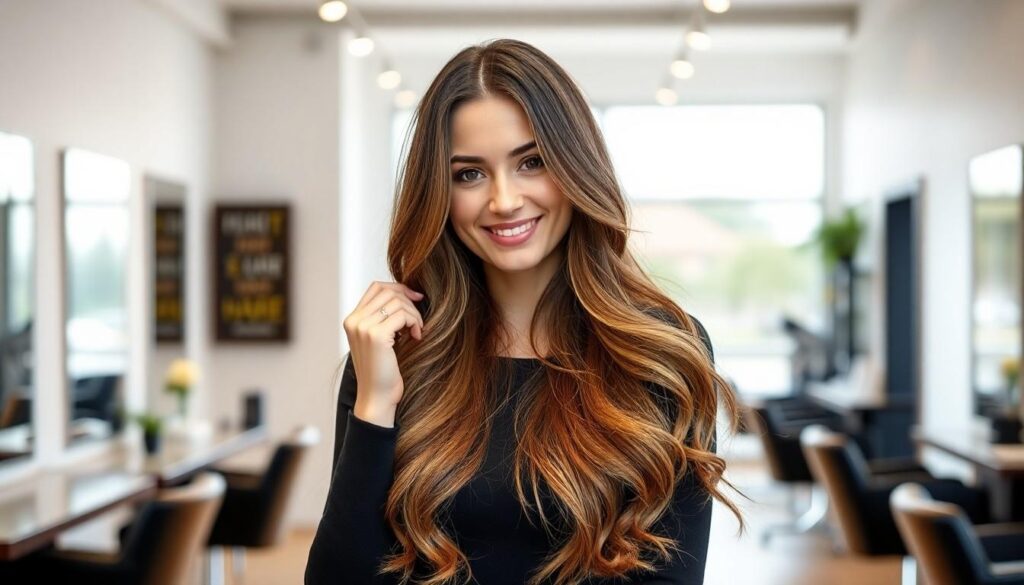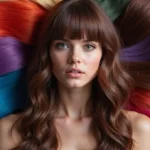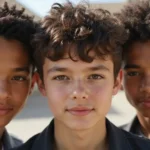Have you ever wondered how to achieve those stunning, sun-kissed highlights that look completely natural? Balayage hair colors offer exactly that effortless, dimensional look that’s taken the beauty industry by storm. This French-inspired coloring technique creates a gorgeous gradient effect that grows out beautifully without harsh lines or constant touch-ups.
We’ve gathered everything you need to know about this revolutionary hair coloring method that works on virtually all hair types and colors. From rich caramels and warm honeys to cool ash tones and vibrant pastels, balayage offers endless possibilities to enhance your natural beauty. Whether you’re a balayage beginner or looking to refresh your look, you’ll discover why this technique continues to dominate hair color trends year after year.
What Is Balayage Hair Coloring and Why It’s So Popular
Balayage is a French word meaning “to sweep” or “to paint,” which perfectly describes this freehand hair coloring technique where color is painted onto the hair surface. Unlike traditional foil highlights that start at the root, balayage creates a graduated, natural-looking effect with less noticeable regrowth. The technique involves strategically painting lighter sections on the hair to create dimension and movement that mimics how sunlight naturally lightens hair.
Many celebrities and influencers have embraced balayage, contributing significantly to its widespread popularity in recent years. This technique stands out because it’s customizable to any hair type, length, or natural color, making it universally flattering for everyone. Professional colorists love balayage because it allows them to create bespoke looks customized specifically to complement each client’s unique features and style preferences.
The low-maintenance nature of balayage makes it particularly appealing to busy individuals who can’t commit to frequent salon visits. With traditional highlighting methods, roots become obvious within 4-6 weeks, while balayage can look fresh for 3-4 months because of its deliberate grow-out pattern. Clients appreciate fewer touch-up appointments, saving both time and money while still maintaining beautiful, dimensional hair color.
Hair health remains intact with balayage compared to other coloring techniques because it typically uses less bleach and applies it more strategically. The process often damages hair less than full-head color treatments since colorists can avoid oversaturating already-lightened sections during touch-ups. Modern formulations of lighteners and toners have also improved, incorporating bond-building technology that helps preserve hair integrity during the lightening process.
The versatility of balayage truly sets it apart in the industry of hair coloring. Clients can choose subtle sun-kissed highlights or bold, contrasting pieces depending on their desired look. This adaptability explains why balayage has transcended being just a trend to become a staple service offered in virtually every high-end salon worldwide.
10 Stunning Balayage Hair Colors to Try in 2025

Caramel Balayage for Brunettes
Caramel balayage offers brunettes a perfect way to add dimension with warm, golden tones that complement dark hair beautifully. This versatile style can be executed in multiple ways, such as a brunette-to-blonde pattern that creates more volume and fullness to your hair. Light caramel sweeps provide a subtle enhancement that still catches attention, especially when styled in loose waves for maximum impact. Many stylists combine caramel with ash brown tones for a natural yet contemporary look, while others create low gradient balayage to add warm caramel waves throughout natural brunette bases.
Sun-Kissed Blonde Balayage
Sun-kissed blonde balayage mimics the natural lightening effect that happens after spending days in the sunshine. This technique focuses on adding lighter blonde tones primarily toward the ends and around the face, creating an effortless, beach-ready appearance. The gradual transition from darker roots to lighter ends makes this style particularly low-maintenance while still delivering that coveted “just back from vacation” glow. Natural-looking dimension comes from the seamless blend between your base color and the hand-painted highlights.
Rose Gold Balayage
Rose gold balayage combines warm blonde tones with subtle pink hues for a romantic, trendy look that flatters many skin tones. This metallic-inspired shade creates a soft, feminine appearance that’s both sophisticated and playful. The delicate pink undertones can be adjusted to be more subtle for professional environments or more vibrant for those wanting to make a statement. Painters of this technique typically focus the rosy tones on mid-lengths and ends for a gradual color melt that catches light beautifully.
Ash Brown Balayage
Ash brown balayage incorporates cool, smoky tones that create a modern twist on classic brown hair. This sophisticated style combats brassiness while adding dimension to natural brunette shades. Stylists often pair ash brown with caramel accents to create depth and contrast that enhances the overall look. The cool undertones of this balayage variation complement fair to medium skin tones particularly well. Most ash brown balayage applications focus on creating a natural gradient that doesn’t appear too stark or contrived.
Vibrant Red Balayage
Vibrant red balayage adds bold, fiery dimensions to your hair for those looking to make a dramatic statement. This eye-catching style ranges from deep burgundy to bright copper red, allowing customization based on your personal style and skin tone. The painted technique ensures the red tones appear natural rather than uniform, creating movement and depth throughout your hair. Maintenance requires color-safe products to prevent fading, as red pigments typically require more care to preserve their intensity.
Silver and Platinum Balayage
Silver and platinum balayage creates an icy, dramatic effect that’s both modern and edgy. This high-contrast style typically requires important lightening of the hair before applying the silver or platinum tones for maximum impact. The cool metallic finish reflects light beautifully, making your hair appear shinier and more dimensional. Many stylists create a shadow root with this technique to ensure a more natural grow-out process and to reduce damage to the root area.
Chocolate Mocha Balayage
Chocolate mocha balayage blends rich, deep brown bases with warmer mocha highlights for a luscious, dimensional look. This delicious color combination adds depth and movement to dark hair without creating too stark of a contrast. The deep cocoa tones create a sophisticated style that works beautifully in professional settings while still providing visual interest. Similar to caramel balayage but with deeper, more chocolate-influenced tones, this style offers warmth and richness to brunettes seeking subtle enhancement.
Honey Blonde Balayage
Honey blonde balayage incorporates warm, golden highlights that resemble natural honey tones for a sun-drenched effect. This universally flattering shade adds warmth and dimension to various base colors, from light brown to dark blonde. The golden hues can be combined with caramel accents for an even more vibrant and glossy finish that catches light beautifully. Many clients choose honey blonde balayage for its ability to brighten the complexion while maintaining a natural, believable appearance.
Copper Balayage
Copper balayage infuses hair with warm, reddish-gold tones that create a vibrant, attention-grabbing look. This fiery shade particularly complements cool skin tones, adding warmth and creating striking contrast against blue or green eyes. The hand-painted application ensures the copper elements appear natural rather than uniform, creating movement throughout the hair. Most stylists focus the brightest copper tones around the face and ends to frame features beautifully while maintaining depth at the roots.
Pastel Rainbow Balayage
Pastel rainbow balayage incorporates soft, multi-colored hues like lavender, mint, rose, and baby blue for a playful, fashion-forward statement. This creative technique allows for personal expression through custom color combinations while maintaining a sophisticated application method. The gentle pastel tones create a more wearable version of vibrant rainbow hair, making it accessible for more conservative environments. Many stylists place these colors strategically throughout the hair to create a harmonious blend rather than obvious stripes of color.
How to Choose the Perfect Balayage Hair Color for Your Skin Tone

For Warm Skin Tones
Warm skin tones naturally have golden or yellow undertones that pair beautifully with complementary balayage colors. Opt for warm, honey-like tones or golden highlights to enhance your natural glow. Caramel, honey blonde, and rich warm browns create stunning dimension while flattering your complexion. These warmer shades reflect light in a way that brightens your features and creates harmony with your skin’s natural warmth. Avoid cool or ashy tones completely, as they can make warm-toned skin appear sallow or unhealthy.
For Cool Skin Tones
Cool skin tones feature pink or blue undertones that look most striking with balayage colors in similar temperature families. Choose cool, ashy, or platinum tones to create a cohesive and flattering look. Icy blonde, ash brown, and cool reds enhance your natural skin color while creating sophisticated dimension in your hair. These cooler-toned balayage options complement the natural coolness in your complexion rather than fighting against it. Warm or golden tones often clash with cool skin tones, potentially making your skin appear tired or washed out.
For Neutral Skin Tones
Neutral skin tones offer the ultimate flexibility when selecting balayage colors due to their balanced mix of warm and cool undertones. You can confidently experiment with either warm or cool-toned balayage based entirely on personal preference. Natural blondes, rich browns, and subtle red highlights all work beautifully with neutral complexions. The key lies in finding the perfect balance that enhances your natural skin tone without leaning too heavily toward either warm or cool extremes. Professional stylists often recommend neutral-toned individuals try both options to discover which best aligns with their style goals and features.
The Difference Between Balayage, Ombré, and Highlights
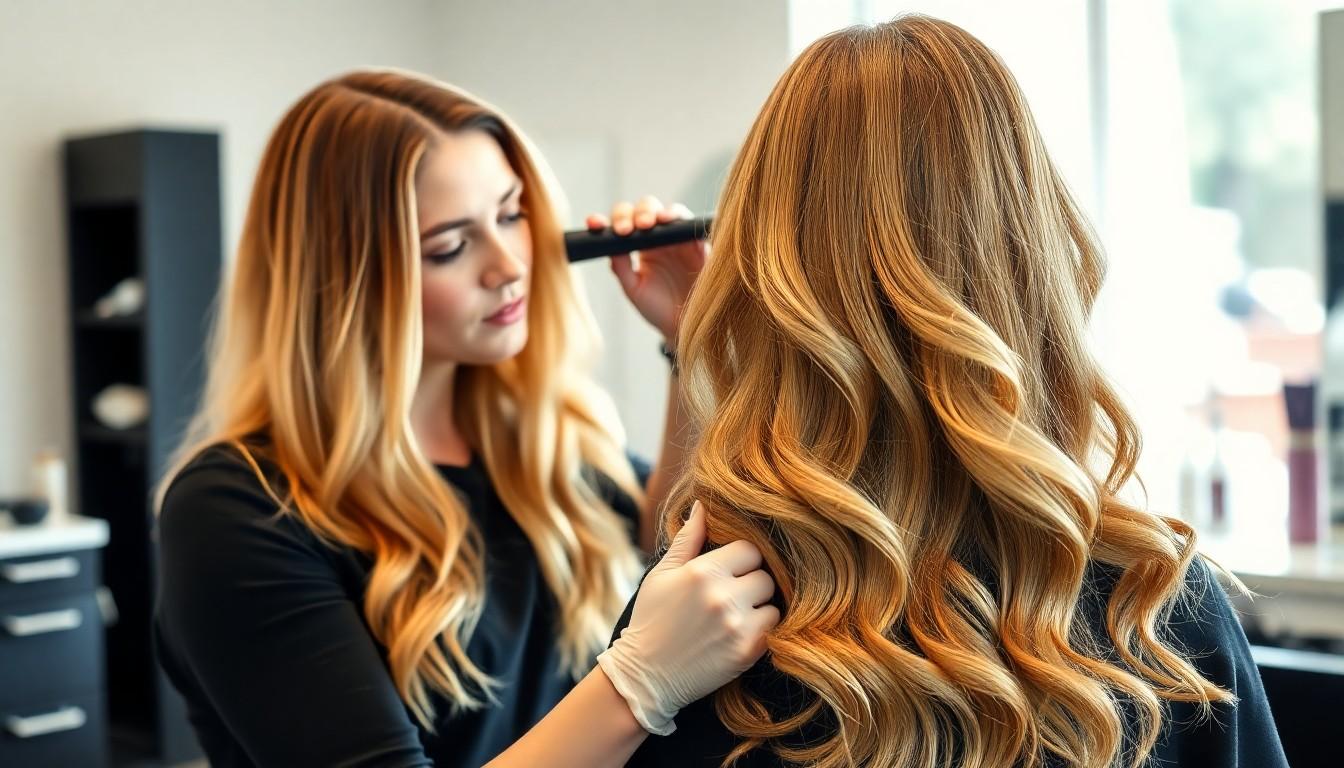
Balayage Technique
Balayage creates a natural, sun-kissed effect through freehand application without foils. This French-inspired technique (meaning “to sweep” or “to paint”) involves hand-painting color directly onto the hair surface for a graduated, natural look. Hair colorists strategically apply lightener to areas that would naturally catch sunlight, resulting in soft transitions between colors. The customizable nature of balayage allows stylists to tailor the color placement specifically to complement your skin tone and hair texture, making each balayage truly unique.
Ombré Technique
Ombré delivers a distinct gradient effect with a more uniform transition from dark to light. Unlike balayage’s subtle blend, ombré features a more noticeable color shift from roots to ends with a clearer demarcation line between the two tones. The technique creates a bold, two-toned appearance that makes a stronger statement than the whisper of color balayage offers. Ombré follows a more predictable pattern while still allowing for customization, though it lacks the same artistic freedom that balayage provides.
Highlights Technique
Highlights use foils to create distinct, uniform strands of color throughout the hair. Traditional highlighting involves sectioning hair and wrapping selected strands in foil to apply lightener, creating a more consistent and pronounced color difference. The foil method produces more defined separation between colored and natural hair, resulting in a more structured look compared to balayage’s blended effect. Highlights can be customized by varying thickness and placement but typically don’t achieve the same natural, sun-kissed appearance that makes balayage so popular.
Key Differences
Balayage offers the most natural-looking result with soft transitions and requires less maintenance than other techniques. Ombré creates a more dramatic two-tone effect with a distinct gradient from dark to light. Highlights provide precise color placement with more uniform, clearly defined streaks throughout the hair. Application methods vary significantly among these techniques – balayage uses freehand painting, ombré focuses on creating a gradient effect, and highlights rely on foil separation. Maintenance requirements differ as well, with balayage typically needing touch-ups every 3-4 months compared to highlights that often require maintenance every 6-8 weeks.
Maintaining Your Balayage Hair Color: Top Care Tips

Balayage hair color requires exact maintenance to preserve its beautiful gradient effect and vibrant tones. With proper care, you can extend the life of your color investment and keep those sun-kissed highlights looking fresh between salon visits.
Washing Frequency
Limiting your hair washing to 2-3 times per week significantly extends the life of your balayage color. Frequent washing strips away natural oils and causes color to fade much faster than necessary. Always wait at least 48 hours after your balayage appointment before washing your hair to allow the color to fully settle into the hair cuticle. Spacing out your wash days gives your color more staying power and maintains the health of your hair simultaneously.
Use of Dry Shampoo
Incorporating dry shampoo into your hair care routine serves as a game-changer for balayage maintenance. Apply dry shampoo to your roots between washes to absorb excess oil and extend your wash cycle naturally. This simple practice not only preserves your color but also adds volume and texture to your hair. Many balayage specialists consider dry shampoo an essential tool for maintaining the fresh-from-the-salon look longer.
Hair Treatments and Conditioning
Weekly deep conditioning treatments represent an essential step in preserving vibrant balayage. Apply a hydrating mask to your hair once weekly to restore moisture and prevent brittleness that can make color appear dull. Never skip conditioner after shampooing, as properly moisturized hair reflects light better and makes your balayage colors appear more dimensional. Conditioning treatments specifically formulated for color-treated hair deliver nutrients that seal the cuticle and lock in pigment.
Hair Oil Application
Applying lightweight hair oil to the ends of your balayage hair provides crucial hydration where it’s needed most. Focus on using just a small amount of argan, avocado, or macadamia oil on damp hair after washing. These oils seal the hair cuticle, add shine, and protect the most processed portions of your balayage from environmental damage. Regular oil application prevents the dry, strawlike appearance that can develop in highlighted ends over time.
Products Worth Investing In
Color-protecting shampoos and conditioners specially formulated with lower sulfate content preserve balayage vibrancy significantly longer than regular formulas. Products labeled specifically for color-treated hair contain ingredients that seal the cuticle and prevent color molecules from washing away prematurely.
Quality dry shampoo becomes essential for extending time between washes while maintaining a fresh, clean appearance. Many professional stylists recommend investing in a dry shampoo that doesn’t leave white residue, which can dull the appearance of your balayage.
Lightweight hair oils designed for color-treated hair deliver multiple benefits including hydration, shine enhancement, and color protection. Focus on products containing argan, avocado, or macadamia oils for the best results on balayage hair.
Color-improving products such as tinted conditioners or color-depositing masks can refresh your balayage between salon appointments. These products temporarily add pigment to maintain tonal balance and counteract brassiness or fading that naturally occurs over time.
Washing and Heat Styling Considerations
Washing your balayage hair correctly means using lukewarm rather than hot water, which opens the cuticle and accelerates color loss. Rinse with cool water at the end of your shower to seal the cuticle and lock in color molecules. Shampooing no more than 2-3 times weekly gives your color maximum longevity while preserving the natural oils that keep your hair healthy.
Heat styling requires careful consideration when maintaining balayage hair. Always apply a heat protectant before using hot tools to create a barrier between your color and damaging high temperatures. Reducing heat styling frequency or using lower temperature settings minimizes color fading and prevents damage to the highlighted sections that are already more vulnerable to breakage. Allowing your hair to air-dry whenever possible preserves both the health and color longevity of your beautiful balayage.
The Cost of Balayage: What to Expect at the Salon

Balayage hair coloring is an investment in your look, with prices varying significantly based on several key factors. Understanding what drives these costs will help you budget appropriately for your salon visit. Let’s explore the main elements that influence balayage pricing and what you can expect to pay.
Duration and Complexity
Balayage application times range from one to four hours depending on your desired result. The complexity of your chosen style directly impacts the price tag, as more intricate color patterns require additional time and expertise. Most salons factor this time commitment into their pricing structure, with longer sessions naturally commanding higher rates.
Hair Length and Thickness
Your hair’s physical characteristics play a crucial role in determining the final cost of your balayage treatment. Longer locks require more product and time to properly color, increasing the overall expense. Similarly, thicker hair demands more color product and careful application technique, which typically results in higher pricing compared to fine or short hair styles.
Colorist’s Experience and Location
Professional expertise significantly affects what you’ll pay for balayage services. Master colorists with years of experience and impressive portfolios usually charge premium rates for their specialized skills. Location also matters tremendously—salons in urban centers or upscale neighborhoods typically set higher prices than those in suburban or rural areas due to higher operating costs and market demand.
Products and Techniques Used
The quality of lightening products and toners selected for your balayage session influences the final price. Luxury color lines and specialized additives like Olaplex (which protects hair integrity during processing) add to the base cost of the service. Advanced application techniques might also come with a higher price point but often deliver superior results worth the extra investment.
Maintenance and Follow-Up
Beyond the initial application, you should budget for ongoing maintenance of your balayage. Regular touch-ups every few months help preserve your color’s vibrancy and blend. Professional-grade color-safe shampoos, conditioners, and treatments represent additional costs that contribute to the long-term investment in your balayage.
General Cost Range
| Service Type | Average Price Range |
|---|---|
| Full Balayage Treatment | $150 – $500+ |
| Touch-up/Maintenance | $75 – $200+ |
The wide price range reflects all the variables mentioned above, from your stylist’s expertise to your hair’s exact needs. Most clients find that balayage represents a better value over time compared to traditional highlighting techniques due to its more graceful grow-out period and less frequent touch-up requirements.
DIY Balayage: Is It Possible to Do at Home?
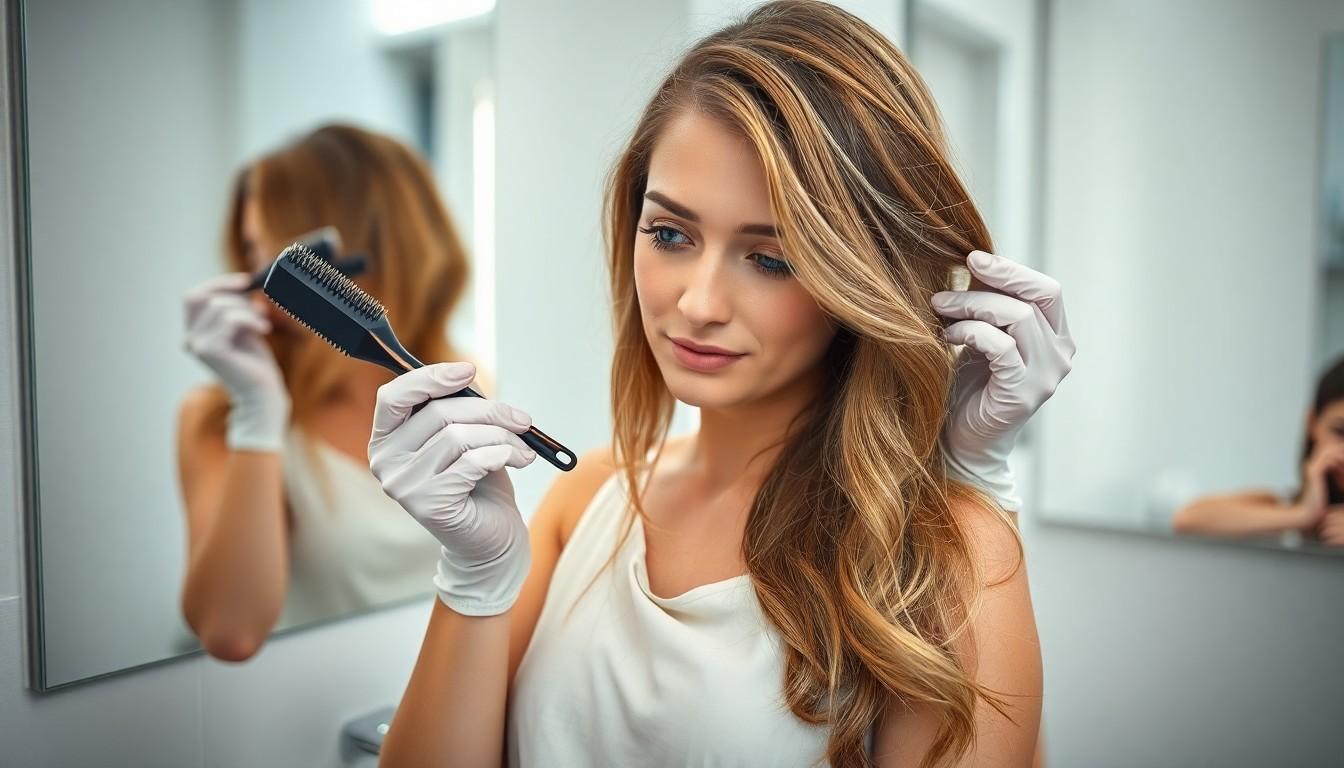
While balayage is typically a salon technique that requires professional expertise, attempting it at home is possible with the right approach and tools. Many hair enthusiasts wonder if they can achieve those sun-kissed highlights without a salon visit. Let’s explore what’s involved in DIY balayage and whether it’s a viable option for your hair coloring needs.
Technique and Application
Balayage involves hand-painting highlights directly onto the hair surface without using foils. This freehand technique creates a soft, natural gradation of lightness that concentrates especially towards the ends. The artistic application allows for a customizable approach to highlighting, mimicking how the sun naturally lightens hair. Professional colorists spend years perfecting this technique, but with patience and practice, you can learn the basic sweeping motions needed for a simple balayage effect.
Tools and Materials Needed
To successfully attempt DIY balayage, you’ll need to gather several essential items:
- A quality balayage kit designed for home use
- Sectioning clips to separate hair portions
- Protective gloves to prevent skin staining
- Multiple mirrors for viewing different angles
- Foil sheets for certain sections if needed
- A wide-tooth brush for application
- Toner to achieve your desired shade
Having all these tools prepared before starting will make the process much smoother and help you achieve more professional-looking results.
Hair Color Considerations
Your current hair color significantly impacts your DIY balayage journey. Dark brown or black hair typically requires multiple bleaching sessions to achieve lighter shades like icy blonde. Starting with more subtle options like caramel or auburn balayage often works better for beginners with darker hair. Existing blonde or previously lightened hair provides an advantage, making it easier to achieve champagne or icy balayage effects. We recommend considering your base color carefully when planning your DIY balayage project to set realistic expectations.
Challenges and Precautions
DIY balayage presents more challenges than other at-home coloring methods due to its artistic nature. Incorrect application commonly leads to uneven results or harsh lines instead of the desired subtle gradient. Always perform a strand test on a small, hidden section of hair before committing to full application. Following product instructions precisely is crucial to prevent damage or unexpected color outcomes. Remember that professional colorists have extensive training to perfect this technique, so approach your DIY attempt with realistic expectations.
Steps for DIY Balayage
- Carefully section your hair using clips, working with small portions at a time
- Apply pre-lightener or color using sweeping, upward motions starting lighter at the ends
- Focus your application on areas that would naturally catch sunlight, particularly face-framing pieces
- Work in a well-lit area with multiple mirrors to ensure even application
- Allow the product to develop according to the instructions in your kit
- Rinse thoroughly and follow with color-safe conditioner
- Apply toner if needed to achieve your desired shade
The key to successful DIY balayage lies in the application technique—use light, feathered strokes that gradually become more sparse toward the roots for that authentic sun-kissed look.
Celebrities Sporting Gorgeous Balayage Hair Colors

Halle Berry
Halle Berry showcases one of the most iconic balayage looks in Hollywood. Her warm brunette base is enhanced with softly painted blonde strands that create an effortless, natural transition. These subtle highlights frame her face perfectly, adding dimension and warmth to her signature short to medium-length styles.
Lucy Hale
Lucy Hale’s balayage features striking light ends with face-framing blonde pieces that brighten her overall appearance. The Pretty Little Liars star opts for a perfect balance between her darker roots and lighter tips, creating an all-over glow that’s especially flattering for summer. Her dimensional color demonstrates how balayage can enhance shorter cuts with movement and depth.
Chrissy Teigen
Chrissy Teigen rocks a bright, sunny balayage that transitions seamlessly from her darker roots to light honey tones. Her color placement appears completely natural, mimicking how the sun would naturally lighten hair. This sun-kissed appearance complements her warm complexion and adds a beachy vibe to her trendy hairstyles.
Jessica Alba
Jessica Alba’s balayage features barely-there streaks that add subtle dimension to her naturally beautiful hair. The actress and entrepreneur maintains a delicate balance with her color, using minimalist highlighting techniques that enhance rather than overwhelm her natural shade. Her approach proves that even the most subtle balayage can make a important impact.
Amber Heard
Amber Heard elevates her one-shoulder styles with a punch of golden blonde highlights throughout her hair. The dramatic contrast between her base color and the golden accents creates a bold statement that frames her face beautifully. Her balayage technique adds important dimension while maintaining a cohesive overall look.
Ciara
Ciara’s balayage showcases a more dramatic transition from dark roots to champagne blonde ends. The singer’s color technique creates a striking gradient effect that complements her complexion and adds sophistication to her various hairstyles. This high-contrast approach demonstrates balayage’s versatility for those seeking a more noticeable color transformation.
Vanessa Hudgens
Vanessa Hudgens enhances her signature dark hair with caramel brunette pieces that create a sophisticated yet modern look. The warm-toned highlights blend seamlessly with her natural color, adding dimension without appearing overly processed. Her balayage style proves that even darker hair can benefit from strategic color placement.
Florence Pugh
Florence Pugh embraces a bold contrast between her hair colors, making her balayage particularly distinctive. The actress’s deliberate style choice creates a striking look that stands out on red carpets and in films alike. Her approach shows how balayage can be customized to create dramatic effects for those seeking a more statement-making look.
Jennifer Lopez
Jennifer Lopez’s blonde balayage perfectly complements her versatile style and famous glow. JLo’s hair transitions smoothly from slightly darker roots to lighter ends, creating a dimensional effect that moves beautifully with her various hairstyles. Her color choice demonstrates how balayage can enhance natural movement in longer hair.
Angelina Jolie
Angelina Jolie opts for cool-toned balayage that enhances her elegant appearance. The softly painted highlights add subtle dimension to her hair without overwhelming her classic style. Her refined approach to balayage proves that even the most understated color techniques can significantly elevate an overall look.
Brenda Song
Brenda Song’s warm-toned balayage creates a bright, vibrant appearance that’s perfect for summer. The actress chooses rich, caramel tones that complement her natural hair color and skin tone. Her sun-kissed highlights demonstrate how balayage can add warmth and dimension to darker base colors.
Izzy Bizu
Izzy Bizu stunned London Fashion Week attendees in 2016 with her perfect blonde balayage curls. The singer’s shimmering highlights enhance her natural curl pattern, adding depth and movement to her hairstyle. Her approach showcases how balayage can particularly enhance textured hair by creating a multi-dimensional effect.
Khloé Kardashian
Khloé Kardashian’s summer-ready balayage highlights give her hair an all-over glow that complements her evolving style. The reality star and entrepreneur frequently updates her look while maintaining the natural dimension that balayage provides. Her color technique demonstrates the technique’s adaptability to different hair lengths and styles.
Olivia Palermo
Olivia Palermo combines gorgeous waves with perfectly placed balayage highlights for a consistently flawless appearance. The fashion icon’s enviable hair features subtle color transitions that enhance her polished aesthetic. Her approach to balayage exemplifies how strategic color placement can elevate even the most sophisticated styles.
Conclusion: Embracing the Balayage Revolution
Balayage has revolutionized the hair coloring industry for good reason. It’s more than just a trend—it’s a versatile technique that offers something for everyone regardless of hair type or color preference.
We’ve seen how this French-inspired method delivers natural-looking dimension while minimizing damage and maintenance. From caramel tones to vibrant pastels the possibilities are truly endless.
Whether you’re visiting a salon professional or attempting a DIY approach remember that balayage is an investment in your personal style. With proper care and the right color choice for your skin tone you’ll enjoy that sun-kissed glow for months to come.
Ready to transform your look? The balayage revolution awaits—and it’s here to stay.
Frequently Asked Questions
What is balayage hair coloring?
Balayage is a French technique meaning “to sweep” or “to paint” where hair color is applied freehand directly onto the hair surface. This creates natural-looking, sun-kissed highlights with a beautiful gradient effect. Unlike traditional highlighting methods, balayage results in softer, less noticeable regrowth and a more customized look that flatters all hair types and lengths.
How is balayage different from highlights and ombré?
Balayage uses a freehand painting technique for natural, soft transitions, while highlights use foils for uniform, structured color strands. Ombré features a more distinct gradient with a clear demarcation line between colors. Balayage requires less maintenance than both alternatives, making it popular for those wanting a stylish yet low-maintenance hair color option.
How long does balayage last?
Balayage typically maintains its fresh look for 3-4 months, compared to traditional highlights which require touch-ups every 6-8 weeks. The natural, graduated effect of balayage allows for a more graceful grow-out period, meaning less frequent salon visits and lower maintenance. This longevity makes it particularly appealing for busy individuals looking for lasting color.
Is balayage damaging to hair?
Balayage is generally less damaging than traditional coloring techniques because it uses less bleach and applies it more strategically. The color is painted only where needed, avoiding unnecessary processing on all hair sections. However, any chemical process can cause some damage, so proper aftercare with quality hair products is essential to maintain hair health.
How much does balayage cost?
Balayage typically costs between $150-$500+ for a full treatment, with touch-ups ranging from $75-$200+. Pricing factors include application complexity, hair length/thickness, colorist experience, and product quality. Despite the higher initial investment compared to traditional highlights, balayage often represents better value over time due to less frequent maintenance needs and graceful grow-out.
Can I do balayage at home?
While DIY balayage is possible, achieving salon-quality results at home is challenging. You’ll need specific tools including a quality balayage kit, sectioning clips, and protective gloves. The technique requires careful application and understanding of hair color principles. For best results, perform a strand test first and follow product instructions precisely to avoid uneven results or damage.
What balayage colors work best for my skin tone?
For warm skin tones, choose warm honey-like shades such as caramel and honey blonde to enhance your natural glow. Cool skin tones look best with cool, ashy tones like icy blonde and ash brown. Those with neutral skin tones have flexibility to choose either warm or cool balayage colors. Professional stylists often recommend trying both options to determine which style best complements your natural complexion.
How should I maintain my balayage color?
Maintain balayage by limiting washing to 2-3 times weekly using color-safe products and lukewarm water. Use dry shampoo between washes, apply weekly deep conditioning treatments, and incorporate lightweight hair oils for hydration. Always use heat protectants when styling. Color-protecting products will extend your balayage’s vibrancy, while minimizing heat styling will prevent fade and damage.
Which hair types work best with balayage?
Balayage works beautifully on all hair types and lengths, from straight to curly and short to long. The technique can be customized to enhance natural texture and movement. It’s particularly striking on layered cuts where the dimension of color can accentuate the shape of the haircut. Even fine hair can benefit from balayage, as the strategic placement of color can create the illusion of fullness.
Can balayage cover gray hair?
Balayage can beautifully blend grays by strategically placing highlights around them, creating a natural, dimensional look. However, it’s not typically the best option for full gray coverage. For comprehensive gray coverage, consider combining balayage with a base color treatment. Consult with a professional colorist who can recommend the most effective approach based on your gray percentage and desired outcome.

